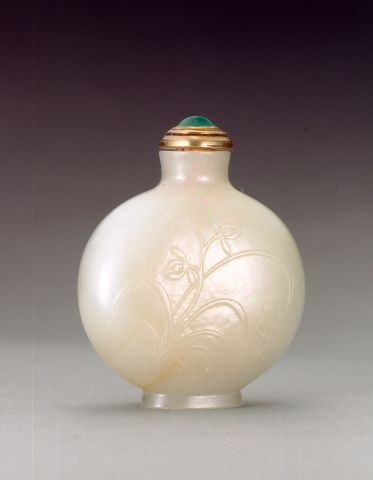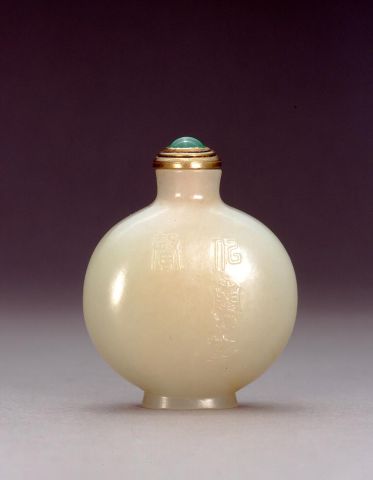

Bottle ID: 228
IMPERIAL, CARVED WITH ORCHIDS
Date: 1736-1799
Height: 50 mm
Nephrite, white, very well hollowed with a heavy base area, and of flattened rounded form, the shoulders sloping to a slightly flared neck with a wide mouth, and with a deeply recessed, splayed foot, carved on one side in raised relief with an orchid growing with two flowers, the reverse with a raised relief inscription in seal script reading 'silan sisheng': 'like orchids so pervasive this fragrance'.
Probably Imperial, attributed to the Palace Workshops, Beijing.
Similar Examples:
Moss, Hugh, Victor Graham and Ka Bo tsang. The Art of the Chinese Snuff Bottle - The J & J Collection, 1993, Vol. I, p. 80, no. 31.
Holden, Rachelle R. Rivers and Mountains Far from the World - The Rachelle R. Holden Collection, 1994, pp. 312-313, no. 138.
Provenance:
Hugh Moss [HK] Ltd.
This superb bottle, which at first glance appears so elegant and simple, belies the artistic inspiration from whence it came. The quality of carving is masterful in its fine detail. Stylistically it is derived from the early Suzhou style, but there is a finesse and precision, about the carving here which is more likely to be a Beijing response to the Suzhou style. It is also possible of course, with the exchange of jade carvers between the various Imperial ateliers that a Suzhou carver temporarily seconded to the Court might have produced such a bottle to impress the Emperor. The attribution to the Palace workshops is based upon a number of features including the excellent hollowing down to the heavy foot area and on the flared foot derived from an ancient ceramic form, which in turn was inspired by earlier bronzes. Such formal references to other materials and to wares in the Imperial collection were common at Court during the Qianlong period. The relief carving of both the design and inscriptions are superb. The inscription itself derives from a line in the Qianzi wen (the Thousand Character Classic) which was composed by the court gentleman Zhou Xingsi under orders from Emperor Wu of the Liang Dynasty (reigned 502-549). The original reading of this inscription was 'scent of the orchid', but this has been replaced by the correct and more profound translation given above. The correct translation is much more intense and refers not just to the decoration on the bottle, but also to the fragrance from inside the bottle. Wherever it was made and under whatever circumstances, it is a highly scholarly bottle with its appropriately subject matter and esoteric script.
< Back to full list
 English
English 中文
中文